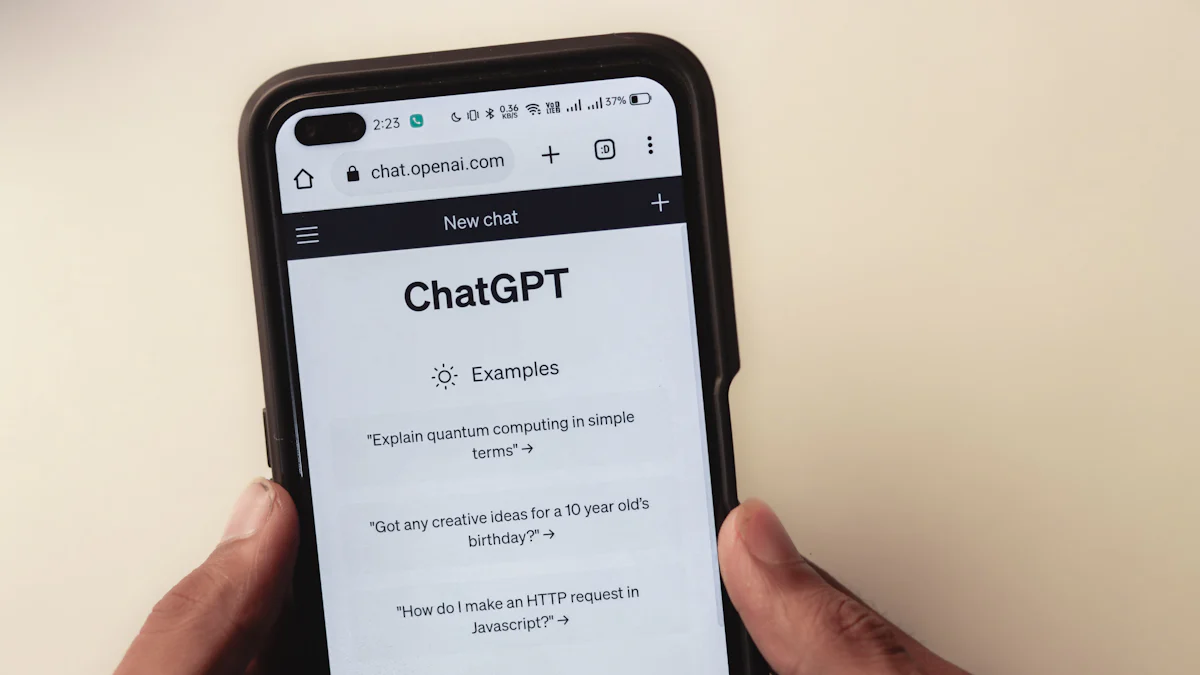Developing a Custom ChatGPT SMS Chatbot with Python: User-Friendly AI Interaction

Custom ChatGPT SMS Chatbot
In today's digital age, the development of custom chatbots has revolutionized user interaction and engagement. One of the most exciting advancements in this field is the creation of a custom SMS chatbot using Python and OpenAI's GPT-3 technology. This innovative approach allows for the seamless integration of AI capabilities into SMS conversations, enabling a user-friendly AI interaction that mimics engaging in meaningful conversations with a real person.
The concept of a custom ChatGPT-like SMS chatbot opens up endless possibilities for businesses and individuals to interact with AI in a more personalized and accessible manner. Whether it's answering queries, providing information, or simply engaging in casual conversation, the custom chatbot offers a unique avenue for AI interaction.
By leveraging this technology, developers can create tailored experiences that cater to specific needs and preferences. The ability to engage in natural language conversations with an AI-driven system represents a significant leap forward in user-friendly AI interaction.
The development of such a custom chatbot not only showcases the potential of AI technology but also paves the way for more immersive and personalized interactions between users and intelligent systems.
Fundamentals of Chatbot Development
Understanding Chatbot Development
Chatbot development forms the backbone of modern AI interaction, playing a pivotal role in enhancing user experiences across various platforms. Understanding the basics of chatbot development is crucial for harnessing the full potential of this technology.
The process of creating a chatbot involves designing and implementing conversational interfaces that can understand and respond to user queries. This includes integrating natural language processing (NLP) algorithms to enable the chatbot to comprehend and generate human-like responses.
Python, as a versatile programming language, plays a significant role in chatbot development due to its rich libraries and frameworks tailored for NLP tasks. Its simplicity and readability make it an ideal choice for building chatbots with sophisticated language processing capabilities.
Chatbot Integration
Integrating SMS capabilities with a chatbot opens up new avenues for user engagement and accessibility. By enabling SMS integration, businesses and individuals can interact with the chatbot using a familiar communication channel, thereby enhancing convenience and reach.
The features and benefits of integrating a chatbot with SMS are multifaceted. It allows users to access information or services via simple text-based interactions, making it an efficient and user-friendly mode of communication. Additionally, SMS integration facilitates seamless communication without the need for specialized applications or internet connectivity.
Chatbot Integration: Integrating SMS capabilities with a chatbot offers unparalleled accessibility and convenience for users, expanding the reach of AI-driven interactions.
Integrating SMS Capabilities
SMS Integration Process
When integrating SMS capabilities into a chatbot, it's essential to understand the underlying process and the tools and technologies involved. The integration process typically involves establishing a connection between the chatbot platform and an SMS gateway, which serves as the interface for sending and receiving text messages.
To enable seamless communication via SMS, developers can utilize APIs provided by telecommunication service providers or third-party platforms specializing in SMS integration. These APIs facilitate the exchange of messages between users and the chatbot, ensuring that incoming queries are processed and appropriate responses are generated.
Exploring the tools and technologies for SMS integration reveals a diverse range of options, including popular SMS gateway providers such as Twilio, Plivo, and Nexmo. These platforms offer comprehensive documentation and developer-friendly APIs that streamline the integration process.
By leveraging these tools and technologies, developers can effectively incorporate SMS capabilities into their custom chatbot, expanding its reach to users who prefer text-based interactions over traditional messaging platforms.
User Engagement via SMS
Enhancing user engagement through SMS interactions with the chatbot is a pivotal aspect of creating a user-friendly AI interaction. By utilizing SMS as a communication channel for the chatbot, developers can ensure that users have convenient access to AI-driven services without relying on internet connectivity or specialized applications.
SMS interactions provide an intuitive and familiar mode of communication for users to ask questions to AI, seek information, or engage in meaningful conversations. This user-friendly approach fosters inclusivity by catering to individuals who may have limited access to internet-enabled devices or prefer text-based communication due to personal preferences.
The seamless integration of SMS capabilities empowers developers to create personalized experiences that resonate with a diverse user base, ultimately enhancing user satisfaction and promoting widespread adoption of AI-driven conversational interfaces.
Leveraging AI Language Generation
AI Language Generation Fundamentals
AI language generation encompasses the fundamental principles and techniques involved in enabling machines to generate human-like text. This revolutionary capability has transformed the landscape of AI interaction, paving the way for more natural and engaging conversations between users and intelligent systems.
The capabilities of AI language generation extend beyond mere text generation, encompassing tasks such as language translation, summarization, and contextual understanding. These multifaceted applications empower chatbots to comprehend user queries effectively and provide contextually relevant responses, thereby enhancing the overall user experience.
AI Language Generation: The advancements in AI language generation have redefined the possibilities of chatbot development, enabling more nuanced and contextually aware interactions with users.
Python and AI Language Generation
Python plays a pivotal role in leveraging AI language generation for chatbot development due to its robust libraries and frameworks tailored for natural language processing (NLP) tasks. The simplicity and flexibility of Python make it an ideal choice for implementing advanced language generation techniques within chatbot systems.
By utilizing Python, developers can seamlessly integrate state-of-the-art language models, including OpenAI's GPT-3, to imbue chatbots with sophisticated language generation capabilities. The availability of pre-trained models and extensive documentation further simplifies the process of incorporating AI language generation into chatbot development workflows.
Moreover, Python's versatility enables developers to experiment with custom training pipelines for fine-tuning language models based on specific use cases or domains. This level of customization empowers developers to create chatbots that exhibit domain-specific conversational abilities while maintaining a user-friendly interface.
User Input Processing
Processing User Input
When it comes to developing a chatbot, processing user input is a critical aspect of ensuring seamless interactions and meaningful responses. Understanding the process of processing user input for the chatbot involves implementing techniques that enable the system to comprehend and interpret the queries or messages received from users.
In the context of chatbot development, Python offers a range of tools and libraries that facilitate efficient user input processing. These tools enable developers to parse and analyze user input, extract relevant information, and determine the appropriate course of action or response.
By leveraging Python's capabilities, developers can implement sophisticated algorithms for natural language understanding (NLU) and intent recognition. These algorithms play a pivotal role in deciphering user input, identifying key phrases or intents, and structuring the data in a format that the chatbot can effectively process.
Implementing user input processing techniques in Python involves integrating NLP libraries such as spaCy or NLTK to handle tasks such as tokenization, part-of-speech tagging, and entity recognition. These techniques contribute to enhancing the chatbot's ability to understand user queries accurately and generate contextually relevant responses.
Enhancing User Experience
Effective user input processing is instrumental in improving the overall user experience when interacting with a chatbot. By ensuring that the chatbot comprehensively processes user queries, developers can guarantee seamless interactions and provide accurate and timely responses based on the input received.
The implementation of robust user input processing techniques contributes to creating an intuitive and responsive chatbot interface. Users are more likely to engage with a chatbot that can effectively understand their queries and provide relevant information or assistance promptly.
Furthermore, enhancing user experience through effective user input processing fosters trust and confidence in the chatbot's capabilities. When users receive accurate and personalized responses based on their inputs, they are more likely to perceive the chatbot as a valuable resource for obtaining information or engaging in meaningful conversations.
Incorporating advanced user input processing techniques not only elevates the functionality of the chatbot but also reinforces its position as a reliable AI-driven interaction platform.
AI Language Generation
Advanced AI Language Generation
Delving into the realm of advanced AI language generation unveils a plethora of cutting-edge techniques and models that elevate the capabilities of chatbots to engage in more sophisticated and contextually relevant conversations. These advancements not only enrich the user experience but also contribute to the overall evolution of AI-driven interactions.
Exploring advanced AI language generation techniques for chatbots involves leveraging state-of-the-art language models, such as OpenAI's GPT-3, to empower chatbots with the ability to generate human-like text that is coherent and contextually relevant. These models are trained on vast datasets, enabling them to produce nuanced and diverse responses based on the input received.
The utilization of cutting-edge AI models for natural language generation represents a significant leap forward in enabling chatbots to comprehend complex queries, infer contextual cues, and deliver responses that resonate with users. By incorporating these advanced techniques, developers can create chatbots that exhibit a deeper understanding of user inputs and provide more insightful and personalized interactions.
Natural Language Processing
Natural language processing (NLP) plays a pivotal role in enhancing the conversational abilities of chatbots by enabling them to understand, interpret, and respond to human language effectively. The integration of NLP techniques empowers chatbots to decipher the nuances of human communication, including semantics, syntax, and context.
By harnessing NLP capabilities, chatbots can enhance their conversational abilities through tasks such as sentiment analysis, entity recognition, and semantic understanding. This enables them to discern underlying emotions or intentions expressed in user queries and tailor their responses accordingly.
Furthermore, natural language processing contributes to the contextual enrichment of conversations between users and chatbots. It enables chatbots to maintain coherence across multiple exchanges and adapt their responses based on evolving dialogue contexts, thereby fostering more natural and engaging interactions.
Incorporating natural language processing into AI language generation equips chatbots with the tools necessary to navigate complex linguistic nuances effectively. This integration enhances their capacity to provide accurate and contextually relevant responses while fostering a more seamless user experience.
User-Friendly AI Interaction
Creating a User-Friendly Experience
Designing a user-friendly interface for the custom ChatGPT chatbot is paramount to ensuring a seamless and engaging interaction for users. By prioritizing user experience, developers can create an environment where users feel comfortable and empowered to engage with the AI chatbot effortlessly.
Streamlined Interface: Implementing a clean and intuitive interface that allows users to navigate the chatbot's functionalities with ease.
Clear Communication: Ensuring that the chatbot conveys information in a clear and concise manner, avoiding ambiguity in its responses.
Intuitive Navigation: Designing the chatbot's interface to facilitate smooth interactions, guiding users through various conversation paths effectively.
Incorporating these elements into the design of the AI chatbot fosters a user-friendly experience, encouraging users to interact with confidence and derive value from their conversations with the intelligent system.
Personalizing User Interactions
Implementing personalized interactions within the custom ChatGPT chatbot adds a layer of customization that resonates with individual users. By tailoring the chatbot's responses based on user preferences and historical interactions, developers can create a more personalized and meaningful experience for each user.
Contextual Responses: Adapting responses based on previous interactions or specific user preferences, creating a sense of continuity in conversations.
Customized Recommendations: Offering personalized suggestions or guidance based on individual user needs or interests, enhancing the relevance of interactions.
Adaptive Tone and Style: Adjusting the chatbot's tone and style of communication to align with each user's communication patterns, promoting relatability.
The integration of personalized interactions elevates the overall AI interaction by making users feel seen and understood, thereby fostering stronger connections between users and the custom ChatGPT chatbot.
NewOaks AI builds custom chatgpt chatbot with google voice and Twillio integration
At NewOaks AI, we are dedicated to pioneering innovative solutions in the realm of AI interaction. Our latest endeavor involves the development of a custom ChatGPT chatbot integrated with Google Voice and Twilio, aimed at revolutionizing user experiences through advanced AI capabilities.
Building a Custom ChatGPT Chatbot: Our team is committed to building a custom chatbot that leverages the power of OpenAI's GPT-3 technology, enabling natural and engaging conversations with users.
Enabling Advanced Functionalities: With the integration of Google Voice and Twilio, our custom chatbot gains advanced functionalities that enhance its communication channels and accessibility.
Enhancing User Experiences: By combining Google Voice and Twilio integration with our custom ChatGPT chatbot, we aim to elevate user experiences by providing seamless and user-friendly interactions with AI-driven systems.
As we continue to push the boundaries of AI interaction, our focus remains on creating tailored solutions that cater to diverse user needs while prioritizing accessibility and engagement.
See Also
Conversing with Your Data: A Detailed Manual for Training ChatGPT with Custom AI Chatbot
Developing a Personalized AI Chatbot for Shopify Using Zapier: A Detailed Tutorial
Incorporating Klaviyo with ChatGPT: A Manual for Personalized Chatbot Application
The Influence of ChatBot: Improving User Experience with AI Chat Bot Software
Wix Real Estate Website Samples: Guide to Developing Custom ChatGPT AI Chatbot

